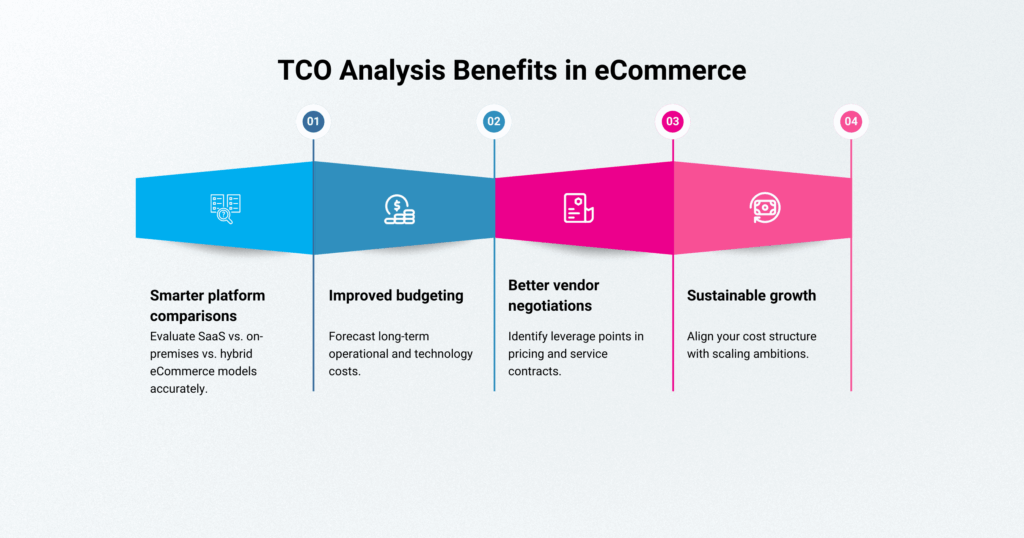
As digital commerce evolves at breakneck speed, eCommerce businesses face mounting pressure to balance growth with profitability. Understanding the Total Cost of Ownership (TCO) for eCommerce platforms is critical for making informed investment decisions that extend beyond subscription or setup fees.
A detailed TCO analysis for eCommerce reveals both the visible and hidden expenses that influence operational efficiency and long-term profitability. Whether you’re evaluating Shopify Plus, BigCommerce, or a custom SaaS solution, knowing your eCommerce cost breakdown can uncover substantial savings and guide smarter platform choices.
What Is TCO Analysis in eCommerce?
TCO analysis in eCommerce is a comprehensive evaluation of all costs associated with owning, operating, and maintaining your online platform over time. Unlike simple cost comparisons, it factors in both direct expenses, such as licensing, hosting, and transaction fees, and indirect costs like maintenance, integrations, upgrades, and customer support.
This holistic view enables eCommerce decision-makers to assess not just the initial price tag but the true long-term investment required to keep their operations competitive and scalable.
Key components of TCO analysis include:
- Software and Licensing: Platform subscriptions, SaaS fees, or custom development costs.
- Hardware and Infrastructure: Servers, hosting, storage, and CDN expenses.
- Maintenance and Support: Security updates, bug fixes, and technical assistance.
- Operational Costs: Staffing, fulfillment, and payment processing.
- Training and Onboarding: Staff education and workflow optimization.
Why TCO Matters for eCommerce Businesses

Understanding TCO is essential for strategic financial planning. A complete eCommerce cost breakdown ensures that decision-makers grasp both short-term and long-term financial commitments.
Benefits of conducting TCO analysis include:
- Smarter platform comparisons: Evaluate SaaS vs. on-premises vs. hybrid eCommerce models accurately.
- Improved budgeting: Forecast long-term operational and technology costs.
- Better vendor negotiations: Identify leverage points in pricing and service contracts.
- Sustainable growth: Align your cost structure with scaling ambitions.
eCommerce Cost Breakdown: Seeing the Full Picture
The eCommerce cost breakdown is the backbone of TCO analysis. It divides expenses into direct and indirect categories, giving a clear sense of where resources are spent—and where optimization is possible.
Direct costs are immediate and easy to quantify:
- Platform licensing or subscription fees
- Transaction and payment gateway costs
- Domain registration and hosting
- Essential integrations and plug-ins
Indirect costs often go unnoticed until they erode margins:
- Staff training and technical support
- Marketing, SEO, and customer acquisition
- Maintenance, upgrades, and downtime risk
- Data storage, analytics, and compliance costs
Comparing eCommerce Platforms Using TCO
Selecting the right eCommerce platform requires evaluating total ownership costs over multiple years, not just upfront pricing. Each model, SaaS, on-premises, or hybrid has unique implications for TCO.
SaaS platforms such as Shopify Plus or BigCommerce offer predictable monthly fees and minimal maintenance overhead. Updates and security are handled by the provider, reducing internal IT costs.
On-premises solutions, like Magento (Adobe Commerce) or custom builds, provide full control but come with higher infrastructure, staffing, and maintenance expenses. Businesses must handle updates, security patches, and hosting.
Hybrid models blend both approaches, offering flexibility and scalability but requiring careful forecasting to avoid unexpected expenses.
When conducting your TCO analysis for eCommerce platforms, include both short-term implementation costs and long-term maintenance projections to make a true apples-to-apples comparison.
Conducting a TCO Analysis: Step-by-Step Guide
A structured approach ensures accuracy and consistency. Here’s a proven framework for analyzing your eCommerce TCO:
- Define Scope: Determine which costs (platform, marketing, fulfillment, etc.) to include.
- Gather Data: Collect all financial and operational data from accounting, IT, and marketing teams.
- Categorize Costs: Split them into direct and indirect categories.
- Forecast Future Costs: Account for scaling, integrations, and infrastructure growth.
- Benchmark and Compare: Use industry standards.
- Analyze ROI and Risks: Assess payback periods, cost efficiency, and risk exposure.
- Document and Review Regularly: Update your analysis at least annually to reflect market and technology changes.
A disciplined TCO analysis process helps ensure accurate forecasting and better decision-making.
How TCO Analysis Drives Cost Optimization
A transparent view of total ownership costs empowers leaders to make data-driven improvements. Effective TCO eCommerce analysis can identify opportunities to:
- Automate workflows to reduce labour and operational overhead.
- Negotiate vendor contracts for better pricing and service levels.
- Streamline marketing spend through data-based performance evaluation.
- Consolidate technology stacks to eliminate redundancy.
For retailers expanding into omnichannel, this visibility supports cost-efficient scaling while maintaining customer experience excellence.
Making Smarter Financial Decisions in eCommerce
Integrating TCO analysis into your eCommerce strategy provides the clarity needed to optimize platforms, streamline operations, and drive sustainable profitability.
A disciplined, data-backed approach helps uncover the true costs behind every click, conversion, and integration, ensuring your eCommerce investments create measurable long-term value.
Explore how Tidal Commerce can help your business maximize ROI and reduce operational costs.


